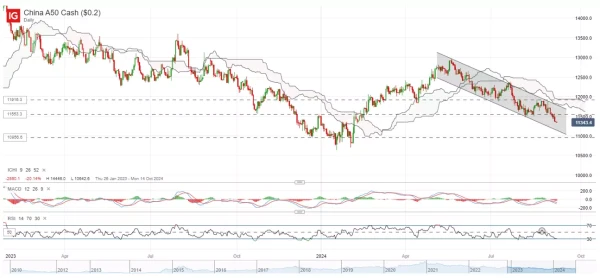Asia Day Ahead: China’s inflation on watch, China A50 at seven-month low
Asia Open
The Asian session looks set for a weak start to the week, with Nikkei -3.19%, ASX -0.79% and KOSPI -2.05% at the time of writing. Another risk-off session on Wall Street last Friday has offered little conviction for risk-taking across the region into the new week, as market participants continued to unwind from growth sectors after their stellar outperformance over the past year. Following the hefty sell-off in the equities market lately, we may expect sentiments to attempt to stabilise near-term as major US indices trades around near-term support. But any recovery will likely be limited as well, as the upcoming Federal Open Market Committee (FOMC) meeting looms.
To end last week, the highly-watched US non-farm payrolls report failed to move the dial around market rate expectations, with a 70% probability for a 25 basis point (bp) cut from the Federal Reserve (Fed) this month remaining as the consensus. Job additions did turn in softer than expected (142,000 versus 164,000 expected) but unemployment rate ticked lower to 4.2% from 4.3% prior, offering a mixed takeaway for investors. Eyes will be on the US inflation data this week, but with the balance of risks having clearly shifted from inflation to growth, market moves could be less sensitive to the pricing data except in the event of any significant surprises.
For now, the Nikkei is dragged to its lowest level in almost a month. Any broader risk aversion may have an amplified effect on Japanese equities, with safe-haven flows potentially supporting the yen which is looked upon as negative for the country’s exporters. On the other hand, losses in Chinese equities may be more limited, given the bearish sentiments already in place and its discounted valuation with its global peers. The Nasdaq Golden Dragon China Index is down 0.8% to end last Friday.
China’s inflation data on watch
The economic calendar will leave China’s inflation data on watch. Back in July, China’s consumer price index (CPI) rose by a more-than-expected 0.5% in July from a year ago, boosted by a surge in pork prices. However, core CPI, which strips out food and energy prices, rose below-expectations at 0.4% year-on-year.
This suggests that pricing pressures are not broad-based and continue to point to a weak domestic demand backdrop for the world’s second largest economy. Signs of the ongoing real estate slump were also reflected in the steeper-than-expected drop in rental prices.
Expectations are for China’s August consumer prices to register a 0.7% increase year-on-year, up from the 0.5% prior. However, producer prices are expected to mark a deeper contraction at -1.4% year-on-year, from the 0.8% contraction prior. Apart from the headline number, markets will be watching for any broad-based price gains to validate any economy recovery.
China A50 dragged to its seven-month low
The lack of conviction around China’s economic recovery continues to leave investors shunning, with the China A50 dragged to its lowest level in seven months. The bearish lean is presented with a failure in its daily relative strength index (RSI) to head back above its mid-line, while a descending channel pattern remains in place. The index also trades below its daily Ichimoku Cloud zone, failing to find room for an upward break amid multiple retests.
Tracking the channel pattern lower could leave the lower trendline at the 11,000 level on watch as potential support. On the upside, a series of resistance may be presented, with the 11,553 level serving as the immediate hurdle for buyers to overcome.
